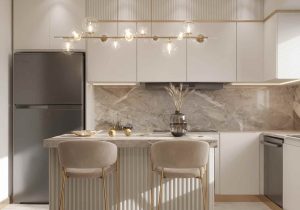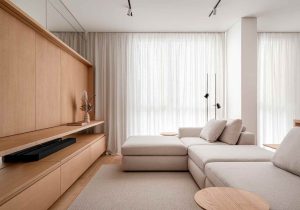Introduction
Compressed or engineered wood is among the most common options for cabinets and furniture among other home interior products. Two of these – MDF and Particle Board are immensely popular, and while both are compressed wood products, they’re different from each other on a few crucial parameters. In this MDF vs Particle Board guide, we put the two head-to-head to understand their differences and how these affect their application in home interiors. Read on to find out more.

What is MDF?
MDF stands for medium-density fibreboard and is made by glueing wood fibres together and compressing them under immense heat to create sheets or boards. This type of engineered wood is inexpensive, easy to paint on due to its smooth surface, strong, and dense, and thus, an immensely popular option among carpenters and homeowners.
What is Particle Board?
Particle Board is another type of engineered wood made by glueing and compressing wood waste. Typically made from recycled timber, it proves to be among the most economical and sustainable options when designing home interiors.
Among the various types of engineered wood, the Particle Board is also the least dense and the lightest due to the gaps in between the particles. The economical price of Particle Board also makes it the ideal choice for use in kitchens the world over. However, since Indian kitchens come in contact with a lot of moisture, most designers avoid using Particle Board as it isn’t very moisture resistant.
However, if it is to be used, it’s done so in spaces that don’t come into contact with water.

Key Differences Between MDF and Particle Board
Particle Board and MDF have several key differences. We explore these in detail below based on several different factors.
- Strength – MDF is stronger due to its higher density than the Particle Board. However, MDF has a lesser density than plywood, which is comparatively stronger as a result.
- Appearance – MDF comes with a smooth look as doesn’t have any grains or knots. In comparison, Particle Board comes with a consistent appearance but is generally rougher. It’s also beige in colour due to the colour of the wood chips.
- Durability – Both MDF and Particle Board are durable materials.
- Moisture-resistance – MDF is comparatively more moisture-resistant when compared to Particle Board but is still susceptible to water damage.
- Lifespan – Both MDF and Particle Board can easily last up to 10 years if maintained well.
- Density – MDF is densely compacted whereas Particle Board is loosely compacted in comparison.
- Painting – While you can directly paint on MDF, you cannot do the same on Particle Board.
- Load carrying – MDF has medium load-bearing capacity, while Particle Board has a lot less load-bearing capacity than MDF as it is loosely compacted.
- Screw-holding capacity – MDF has comparatively higher screw-holding capacity than Particle Board as the former is more densely packed.
- Toxicity – The formaldehyde used to glue the fibre together in MDFC requires you to be a little cautious. On the other hand, Particle Board is eco-friendly and non-toxic.
- Deformation – MDF is susceptible to mild damage, whereas Particle Board can expand when it comes in contact with water.
- Composition – MDF is made of very fine wood fibres and resin, whereas Particle Board is made from sawmill shavings and wood chips and is also less densely packed.
How Much Do MDF and Particle Boards Cost?
When you compare MDF vs Particle Board, you’ll see that MDF costs higher than the latter due to its longevity, and other qualities such as improved screw-holding capacity, increased rigidity, smoother appearance, and the ease of painting on the surface. Here’s a simple breakdown –
- MDF – Rs. 40-90 per square foot.
- Particle Board – Rs 30-60 per square foot.
Pros and Cons of MDF
The next aspect to consider in an MDF vs Particle Board comparison is their pros and cons. We discuss those of MDF in this section and then move on to Particle Board in the next.
Pros
- MDF is the ideal choice for ducco, PU work, and painting.
- It offers great value for money and is economical.
- Due to its greater density, it has better machining capabilities and screw-holding capacity.
- MDF is also easy to cut and drill into without causing any damage.
Cons
- It can crack and split under heavy loads.
- It isn’t moisture resistant, so be sure to use it in spaces that aren’t prone to spillage (avoid countertops, for example)
- It can lead to bubbles when laminate pasting is done. The solution is to use machine paste.
- MDF can easily split or crack when put under stress.
- It’s not as strong as solid wood, but fares better than Particle Board since it’s denser and more tightly packed in comparison.
Pros and Cons of Particle Board
In this section, we take a look at the advantages and disadvantages of using Particle Board in your home interiors.
Pros
- Its low density makes it lightweight.
- It’s more affordable than MDF and significantly more affordable than plywood.
- It offers good thermal and soundproof benefits.
- They don’t come with any natural defects like knots, especially when compared to solid wood.
- Its smooth surface makes it easy to stick veneers or laminates.
Cons
- It’s rather susceptible to moisture damage.
- It offers less screw-holding capacity as it’s loosely packed.
- Lack of proper maintenance can lead to deformities in its shape.
- It’s not as strong as solid wood or even other types of engineered wood, making it crucial that you handle it with care.

How to Choose Between MDF vs Particle Board
The choice between MDF and Particle Board primarily depends on a few key factors and your requirements. Here are a few pointers that can help you make a decision.
- Price – For interiors done on a budget, Particle Board offers a more economical option, while MDF offers increased durability and a more premium feel at a slightly higher price point.
- Finish – If you’re considering painting your furniture, MDF should be your choice. Particle Boards cannot be painted on, but you could use it if you intend to use a veneer or a laminate over the surface.
- Moisture-resistance – When sealed properly, MDF offers better moisture resistance, particularly when used in spaces like bathrooms and kitchens.
- Type of projects – MDF is the ideal choice for projects like doors, frames, and cabinets where you require a smooth finish. On the other hand, Particle Board is the ideal choice for drawer backs and shelves that are not visible, or that can be covered with a laminate.
Design Your Full Home Interiors with Bonito Designs
Your home interiors deserve the best materials, even in the places you wouldn’t care to look. At Bonito Designs, we strive to achieve perfection in everything we do. As India’s only ISO-certified full home interior brand, we ensure the highest standards in terms of quality and have been doing so over the 10+ years of our experience in the full home interior sector.
Our team of 300+ interior designers come with the skills and experience to help you design your home interiors based on your specific preferences.


